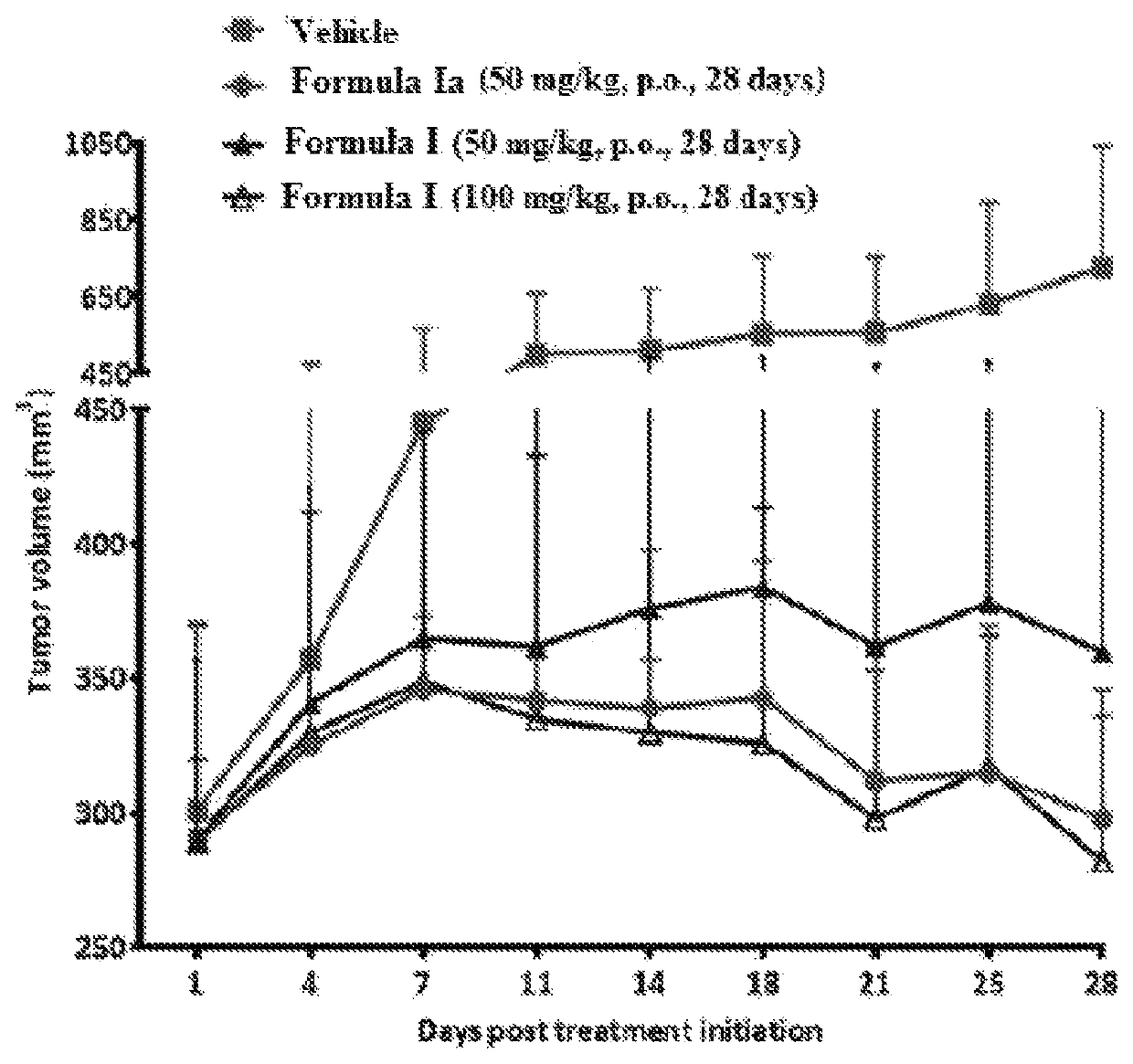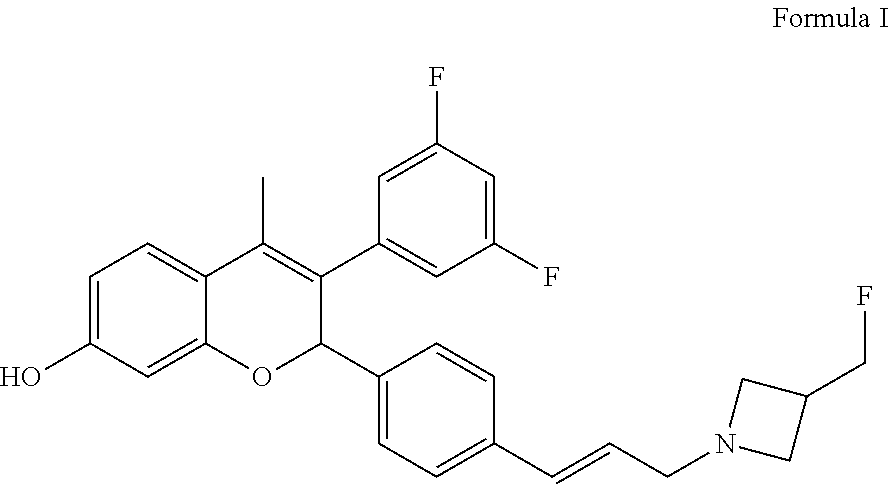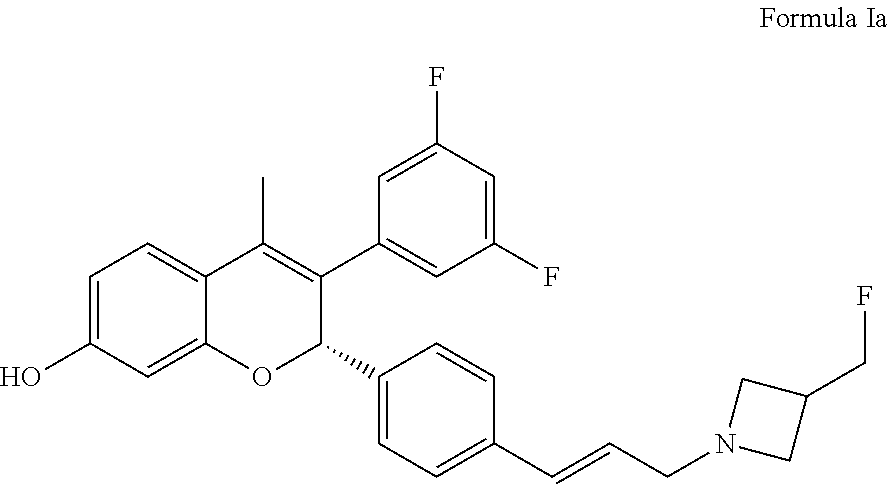Selective estrogen receptor degrader
a selective estrogen receptor and degrader technology, applied in the field of selective estrogen receptor degrader, can solve the problems of limited use by women without oral bioavailability, and achieve the effects of reducing severity, reducing incidence of one, and inhibiting progression
- Summary
- Abstract
- Description
- Claims
- Application Information
AI Technical Summary
Problems solved by technology
Method used
Image
Examples
example 1
on of 3-(3,5-difluorophenyl)-2-{4-[(E)-3-(3-fluoromethyl azetidin-1-yl)propenyl]phenyl}-4-methyl-2H-chromen-7-ol (Compound of Formula I)
[0056]
Step-I: Preparation of 2-(3,5-difluorophenyl)-1-(2,4-dihydroxyphenyl) ethanone
[0057]
[0058]Oxalyl chloride (5.98 mL, 0.070 mol) was added dropwise to a stirred solution of 3,5-difluorophenylacetic acid (10 g, 0.058 mol) and N,N-dimethylformamide (0.5 mL) in dichloromethane (100 mL) at room temperature and was stirred at room temperature for 30 min. The reaction mixture was concentrated under reduced pressure at 30-35° C. and then dissolved in dichloromethane (20 mL). The resultant solution was added to a stirred solution of resorcinol (9.58 g, 0.087 mol) and aluminium chloride (11.60 g, 0.087 mol) in dichloromethane (80 mL) at 0-5° C. and was stirred at room temperature for 16 hours. The reaction was slowly quenched with 2N hydrochloric acid solution (120 mL) at 0-5° C. and stirred for 1 hr at same temperature. The solid was filtered and succes...
example 2
on of (2S)-3-(3,5-difluorophenyl)-2-[4-[(E)-3-[3-(fluoromethyl)azetidin-1-yl]prop-1-enyl]phenyl]-4-methyl-2H-chromen-7-ol (Compound of Formula Ia) and (2R)-3-(3,5-difluorophenyl)-2-[4-[(E)-3-[3-(fluoromethyl)azetidin-1-yl]prop-1-enyl]phenyl]-4-methyl-2H-chromen-7-ol (Compound of Formula Ib)
[0078]
[0079]The enantiomers from the racemic mixture of example 1 were separated by chiral HPLC (Column: Chiralcel® OD-H (250×30 mm, 5μ); mobile phase-n-hexane:ethanol:diethyl amine 900:100:1) wherein R enantiomer (Compound of Formula Ib) was eluted first followed by desired S enantiomer (Compound of Formula Ia). Further the specific optical rotation (SOR) of compound of Formula Ia was determined by using following test conditions:
[0080]Concentration: 1% w / v in acetone;
[0081]Temperature: 25° C.;
[0082]Source of light: Sodium lamp (D line);
[0083]SOR of Compound of Formula Ia: [α]D25=+224.40°
[0084]The chiral purity of compound of Formula Ia was determined by HPLC as per following analytical condition...
example 3
on of 3-(3,5-difluorophenyl)-2-[4-[(E)-3-[3-(fluoromethyl)azetidin-1-yl]prop-1-enyl]phenyl]-4-methyl-2H-chromen-6-ol (Compound 2)
[0091]
[0092]Racemic compound 2 was prepared by following an analogous process of Example 1 (step III-step X) wherein 2-(3,5-difluorophenyl)-1-(2-hydroxy-5-tetrahydropyran-2-yloxy-phenyl)ethanone was used instead of 2-(3,5-difluoro phenyl)-1-[2-hydroxy-4-(tetrahydropyran-2-yloxy)-phenyl]ethanone in step III.
PUM
| Property | Measurement | Unit |
|---|---|---|
| temperature | aaaaa | aaaaa |
| temperature | aaaaa | aaaaa |
| temperature | aaaaa | aaaaa |
Abstract
Description
Claims
Application Information
 Login to View More
Login to View More - R&D
- Intellectual Property
- Life Sciences
- Materials
- Tech Scout
- Unparalleled Data Quality
- Higher Quality Content
- 60% Fewer Hallucinations
Browse by: Latest US Patents, China's latest patents, Technical Efficacy Thesaurus, Application Domain, Technology Topic, Popular Technical Reports.
© 2025 PatSnap. All rights reserved.Legal|Privacy policy|Modern Slavery Act Transparency Statement|Sitemap|About US| Contact US: help@patsnap.com



